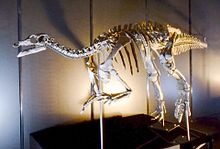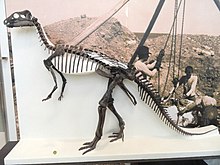彎龍屬
| 彎龍屬 化石時期:晚侏羅世,
| |
|---|---|

| |
| 位於日本的骨骼重建 | |
| 科學分類 | |
| 界: | 動物界 Animalia |
| 門: | 脊索動物門 Chordata |
| 綱: | 蜥形綱 Sauropsida |
| 總目: | 恐龍總目 Dinosauria |
| 目: | †鳥臀目 Ornithischia |
| 亞目: | †鳥腳亞目 Ornithopoda |
| 演化支: | †橡樹龍形態類 Dryomorpha |
| 演化支: | †直拇指龍類 Ankylopollexia |
| 總科: | †彎龍超科 Camptosauroidea Marsh, 1885 |
| 科: | †彎龍科 Camptosauridae Marsh, 1885 |
| 屬: | †彎龍屬 Camptosaurus Marsh, 1885 |
| 模式種 | |
| †全異彎龍 Camptonotus dispar Marsh, 1879
| |
| 其它物種 | |
| 異名 | |
彎龍(屬名:Camptosaurus,發音:/ˌkæmptəˈsɔːrəs/ KAMP-tə-SOR-əs)是一屬植食性的有喙鳥臀目恐龍,生存於晚侏羅世的北美可能還有歐洲。[1]
屬名分別取自古希臘語καμπτος/kamptos(意為「彎曲的」)和σαυρος/sauros(意為「蜥蜴」),意為「可彎曲的蜥蜴」。
描述
[編輯]
彎龍是種體格粗壯的動物,擁有強健的後肢和仍有四趾的寬腳。[2]由於猶他齒龍獨立建屬,因此莫里遜組中哪些材料屬於彎龍已成問題。13號採石場的全異彎龍標本無疑是從很深的地層中發現,地質年齡可能追溯到卡洛維階至牛津階。[3]較年輕地層中的最大碎片表明成年個體體長超過7.9公尺(26英尺)、臀高超過2公尺(6.6英尺)。[4]然而13號採石場個體的體型更小,被描述為長6公尺(20英尺)、重785至874公斤(1,731至1,927英磅)。[5]2010年,格雷戈里·保羅(Gregory Paul)給出更低的估計值:長5米、重半噸。[6]
早期重建(如馬什和吉爾摩的重建)是基於眾神花園龍的顱骨,使彎龍頭部顯示出更方的錯誤輪廓。顱骨實際上呈三角形,具有尖吻及喙狀嘴。與莫里遜組的其它真鳥腳類相比,彎龍下頜齒排列更緊湊,[5]約翰·福斯特(John Foster)將其描述為「側面有較厚的中嵴,邊緣有小齒」,這些特徵與彎龍相似,但發育更良好。[5]彎龍牙齒通常出現大量磨損,表明其飲食中含有堅硬植被。[5]
發現歷史
[編輯]
1879年9月4日,威廉·哈洛·里德(William Harlow Reed)在懷俄明州奧爾巴尼縣發現一具小型真鳥腳類殘骸。同年,奧塞內爾·查利斯·馬什(Othniel Charles Marsh)教授將其描述並命名為彎背龍(Camptonotus)。屬名取自希臘語κάμπτω(「彎曲」)和νῶτον(「背」),意為「可彎曲的背」,指骶椎推測具有靈活性。正模標本YPM 1877為部分骨骼。[7]1885年,馬什將「彎背龍」更名為彎龍(Camptosaurus),因為原名已用於命名某種蟋蟀。[8]1879年,馬什將從化石獵人手中得到的莫里遜組懷俄明州科摩崖附近13號採石場的材料命名為全異彎龍(C. dispar,即模式種),並將亞瑟·雷克斯(Arthur Lakes)在1A採石場發現的腳部化石YPM 1879命名為強壯彎龍(C. amplus),後者已被證實屬於異特龍。[2][9]在整個19世紀80及90年代,馬什繼續從13號採石場接收標本,並於1894年根據體型差異命名另外兩個物種:中型彎龍(C. medius)和侏儒彎龍(C. nanus)。[10]1909年,查爾斯·惠特尼·吉爾摩(Charles W. Gilmore)在對標本作重新描述時又命名兩個物種:布氏彎龍(C. browni)和扁平彎龍(C. depressus)。[11]在莫里遜組,彎龍化石出現於第2至第6地層帶。[12]

1980年,彼得·加爾東(Peter Galton)和H·P·鮑威爾(H. P. Powell)在普氏彎龍(C. prestwichi)的重新描述中將侏儒種、中型種及布氏種視為更大的全異種的不同生長階段或不同性別,因此只有全異彎龍是有效種。[2]他們還將顱骨YPM 1887歸入全異種,該化石於1886年被馬什歸入強壯種,之後被吉爾摩再次確認。吉爾摩曾用該顱骨描述彎龍顱骨,但後來被布瑞爾和卡彭特證實不屬於彎龍,並於2007年創建獨立屬種克氏眾神花園龍。[13]

南達科他州熱泉附近的拉科塔組發現扁平彎龍化石。1909年,查爾斯·吉爾摩根據正模標本兼唯一已知標本USNM 4753――一塊破碎的顱後骨骼――對其進行描述,其特徵是「髂骨狹窄或凹陷」。[11]卡彭特和威爾遜(2008年)根據髂骨與毒扁臀龍正模標本間的相似性而將其更名為扁平扁臀龍。[3] 然而,麥克唐納及其同事(2010年)和麥克唐納(2011年)發現扁平種的水平髖臼後突更可能是化石變形的結果,[14]並為其建立新屬峽谷龍。[15]2008年,卡彭特和威爾遜根據恐龍國家紀念公園的標本命名新種隱士彎龍(C. aphanoecetes),[3]其與全異種的區別在於下頜骨、更短的頸椎、更直且末端有一小「腳」的坐骨。安德魯·麥克唐納(Andrew McDonald)和同事2010年的分析表明隱士種與衍生禽龍類(硬棘龍類)關係更近。[14]隱士種現已建立新屬猶他齒龍。[15]

當馬什描述北美彎龍物種時,歐洲也有大量物種於19世紀末和20世紀初歸入本屬,包括尹氏彎龍(C. inkeyi)、霍氏彎龍(C. hoggii)、利氏彎龍(C. leedsi)、普氏彎龍(C. prestwichi)及凡登彎龍(C. valdensis)。尹氏種(Nopcsa, 1900)化石由羅馬尼亞哈采格盆地晚白堊世地層中的齒骨和關節等零散材料組成,幾乎可以確認屬於凹齒龍科,現已不再被視為有效(疑名)。[16]凡登種是種可疑的橡樹龍科,[17]正模標本兼唯一標本NHMUK R167是一截保存不好、遠端缺失的左股骨,因此很難與其它橡樹龍科比較(包括同期共存的小溝曠野龍)。[15]利氏種可能是橡樹龍科的有效屬之一,現已成為獨立屬卡洛夫龍。[18]霍氏彎種最初由理察·歐文(Richard Owen)於1874年命名為霍氏禽龍,並於2002年被諾曼和巴雷特歸入彎龍,[19]後來獨立為新屬歐文齒龍。[17]
另一歐洲物種稱作普氏彎龍(C. prestwichii),化石出自英國牛津郡赫斯特山的查利磚坑(Chawley Brick Pits),是在一輛電車駛入山坡時被人發現。1880年,赫克將其命名為普氏彎龍,之後絲萊於1888年將其建立為新屬庫姆納龍,但很快被萊德克於次年歸入彎龍。[20]然而,耐許和馬提爾(2008年)、麥克唐納及同事(2010年)和麥克唐納(2011年)先後發現絲萊之前獨立建屬的有效性。庫姆納龍已被發現是種硬棘龍類,與衍生禽龍類的關係比彎龍更近,情況類似猶他齒龍。[14][15]
2022年,首批確認屬於彎龍未定近似種的歐洲遺骸由桑切斯-費諾羅薩等人正式描述。[1]在西班牙維拉-德-阿索維斯波組組富恩特西利亞段(Fuentecillas member)發現了一件標本,由一個前段頸椎椎體、一個前段背椎椎體、一個背骶椎體、四個骶骨椎體、一個尾骶椎體、兩個前段尾椎椎體、三個中段尾椎椎體及左肱骨遠端的一塊碎片。富恩特西利亞標本被認為更近似於葡萄牙侏羅紀的彎龍而非龍爪龍,[21]因此被暫時歸入彎龍。[1]
分類
[編輯]1885年,馬什為該屬建立單獨的彎龍科(Camptosauridae),而一些研究者認為它是禽龍科的早期成員。
現代研究將彎龍歸入直姆指龍類演化支,並確認為該演化支的基幹成員,表明該屬與後來禽龍類及鴨嘴龍科的祖先關係密切,並且較同時期的橡樹龍、德林克龍和奧斯尼爾洛龍更為衍生。[5]
麥克唐納及其同事2010年和2011年系統發育分析中本屬的位置如下:[15][22]

| 直姆指龍類 Ankylopollexia |
| ||||||||||||||||||||||||||||||||||||||||||||||||
古生物學
[編輯]
根據對其它禽龍類的研究,科學家認為其奔跑速度可能已達到每小時25公里(16英里)。[5]猶他州恐龍國家紀念公園莫里遜組發現了一個9英寸(230公釐)的微型胚胎化石,現已歸入彎龍。[5]
參見
[編輯]參考資料
[編輯]- ^ 1.0 1.1 1.2 Cubells-Alarcó, M.; Verdú, F. J.; Suñer, M.; de Santisteban, C. Tracing Late Jurassic ornithopod diversity in the eastern Iberian Peninsula: Camptosaurus-like postcranial remains from Alpuente (Valencia, Spain). Journal of Iberian Geology. 2022-01-08. ISSN 1698-6180. doi:10.1007/s41513-021-00182-z (英語).
- ^ 2.0 2.1 2.2 Galton, P.M.; Powell, H.P. The ornithischian dinosaur Camptosaurus prestwichii from the Upper Jurassic of England. Palaeontology. 1980, 23: 411–443.
- ^ 3.0 3.1 3.2 Carpenter, K.; Wilson, Y. A new species of Camptosaurus (Ornithopoda: Dinosauria) from the Morrison Formation (Upper Jurassic) of Dinosaur National Monument, Utah, and a biomechanical analysis of its forelimb. Annals of the Carnegie Museum. 2008, 76 (4): 227–263. doi:10.2992/0097-4463(2008)76[227:ansoco]2.0.co;2.
- ^ Erickson, Bruce R. Dinosaurs of the Science Museum of Minnesota. St. Paul, Minnesota: The Science Museum of Minnesota. 2003: 33. ISBN 978-0-911338-54-6.
- ^ 5.0 5.1 5.2 5.3 5.4 5.5 5.6 Foster, J. (2007). "Camptosaurus dispar." Jurassic West: The Dinosaurs of the Morrison Formation and Their World. Indiana University Press. p. 219-221.
- ^ Paul, G.S., 2010, The Princeton Field Guide to Dinosaurs, Princeton University Press p. 284
- ^ Marsh, O.C. Notice of new Jurassic reptiles. American Journal of Science and Arts. 1879, 18 (108): 501–505 [2022-05-13]. Bibcode:1879AmJS...18..501M. S2CID 131001110. doi:10.2475/ajs.s3-18.108.501. (原始內容存檔於2022-05-13).
- ^ Marsh, O.C. Names of extinct reptiles. American Journal of Science. 1885, 29: 169.
- ^ Bakker, R.T. Dinosaur mid-life crisis: the Jurassic-Cretaceous transition in Wyoming and Colorado. Lucas, S.G.; Kirkland, J.I.; Estep, J.W. (編). Lower and Middle Cretaceous Terrestrial Ecosystems 14. New Mexico Museum of Natural History and Science Bulletin. 1998: 67–77.
- ^ Marsh, O.C. The typical Ornithopoda of the American Jurassic. American Journal of Science. 3. 1894, 48 (283): 85–90 [2022-05-13]. Bibcode:1894AmJS...48...85M. S2CID 130777820. doi:10.2475/ajs.s3-48.283.85. (原始內容存檔於2021-07-24).
- ^ 11.0 11.1 Gilmore, C.W. Osteology of the Jurassic reptile Camptosaurus, with a revision of the species of the genus, and descriptions of two new species. Proceedings of the United States National Museum. 1909, 36 (1666): 197–332 [2022-05-13]. doi:10.5479/si.00963801.36-1666.197. (原始內容存檔於2022-03-15).
- ^ Foster, J. (2007). "Appendix." Jurassic West: The Dinosaurs of the Morrison Formation and Their World. Indiana University Press. pp. 327-329.
- ^ Brill, K.; K. Carpenter. A description of a new ornithopod from the Lytle Member of the Purgatoire Formation (Lower Cretaceous) and a reassessment of the skull of Camptosaurus. Carpenter, Kenneth (編). Horns and Beaks: Ceratopsian and Ornithopod Dinosaurs. Bloomington and Indianapolis: Indiana University Press. 2007: 49–67. ISBN 978-0-253-34817-3.
- ^ 14.0 14.1 14.2 McDonald, A.T.; Kirkland, J.I.; DeBlieux, D.D.; Madsen, S.K.; Cavin, J.; Milner, A.R.C.; Panzarin, L. New Basal Iguanodonts from the Cedar Mountain Formation of Utah and the Evolution of Thumb-Spiked Dinosaurs. PLOS ONE. 2010, 5 (11): e14075. Bibcode:2010PLoSO...514075M. PMC 2989904
 . PMID 21124919. doi:10.1371/journal.pone.0014075
. PMID 21124919. doi:10.1371/journal.pone.0014075  .
.
- ^ 15.0 15.1 15.2 15.3 15.4 Andrew T. McDonald. The taxonomy of species assigned to Camptosaurus (Dinosauria: Ornithopoda) (PDF). Zootaxa. 2011, 2783: 52–68 [2022-05-13]. doi:10.11646/zootaxa.2783.1.4. (原始內容 (PDF)存檔於2012-04-12).
- ^ Sachs, S.; Hornung, J.J. Juvenile ornithopod (Dinosauria: Rhabdodontidae) remains from the Upper Cretaceous (Lower Campanian, Gosau Group) of Muthmannsdorf (Lower Austria). Geobios. 2006, 39 (3): 415–425. doi:10.1016/j.geobios.2005.01.003.
- ^ 17.0 17.1 Galton, Peter M. Notes on Neocomian (Late Cretaceous) ornithopod dinosaurs from England - Hypsilophodon, Valdosaurus, "Camptosaurus", "Iguanodon" – and referred specimens from Romania and elsewhere. Revue de Paléobiologie. 2009, 28 (1): 211–273.
- ^ Ruiz-Omeñaca, José Ignacio; Pereda Suberbiola, Xabier; Galton, Peter M. Callovosaurus leedsi, the earliest dryosaurid dinosaur (Ornithischia: Euornithopoda) from the Middle Jurassic of England. Carpenter, Kenneth (編). Horns and Beaks: Ceratopsian and Ornithopod Dinosaurs. Bloomington and Indianapolis: Indiana University Press. 2007: 3–16. ISBN 978-0-253-34817-3.
- ^ Norman D.B. and Barrett, P.M. 2002. Ornithischian dinosaurs from the Lower Cretaceous (Berriasian) of England. Palaeontology 68:161-189
- ^ Benton MJ, Spencer PS. Fossil Reptiles of Great Britain. Chapman & Hall. 1995. ISBN 978-0-412-62040-9.
- ^ Mateus, Octávio; Telles Antunes, Miguel. Draconyx loureiroi, a new camptosauridae (Dinosauria, Ornithopoda) from the Late Jurassic of Lourinhã, Portugal. Annales de Paléontologie. January 2001, 87 (1): 61–73 [2022-05-13]. doi:10.1016/S0753-3969(01)88003-4. (原始內容存檔於2018-06-23) (英語).
- ^ McDonald, A.T.; Kirkland, J.I.; DeBlieux, D.D.; Madsen, S.K.; Cavin, J.; Milner, A.R.C.; Panzarin, L. New Basal Iguanodonts from the Cedar Mountain Formation of Utah and the Evolution of Thumb-Spiked Dinosaurs. PLOS ONE. 2010, 5 (11): e14075. Bibcode:2010PLoSO...514075M. PMC 2989904
 . PMID 21124919. doi:10.1371/journal.pone.0014075
. PMID 21124919. doi:10.1371/journal.pone.0014075  .
.








